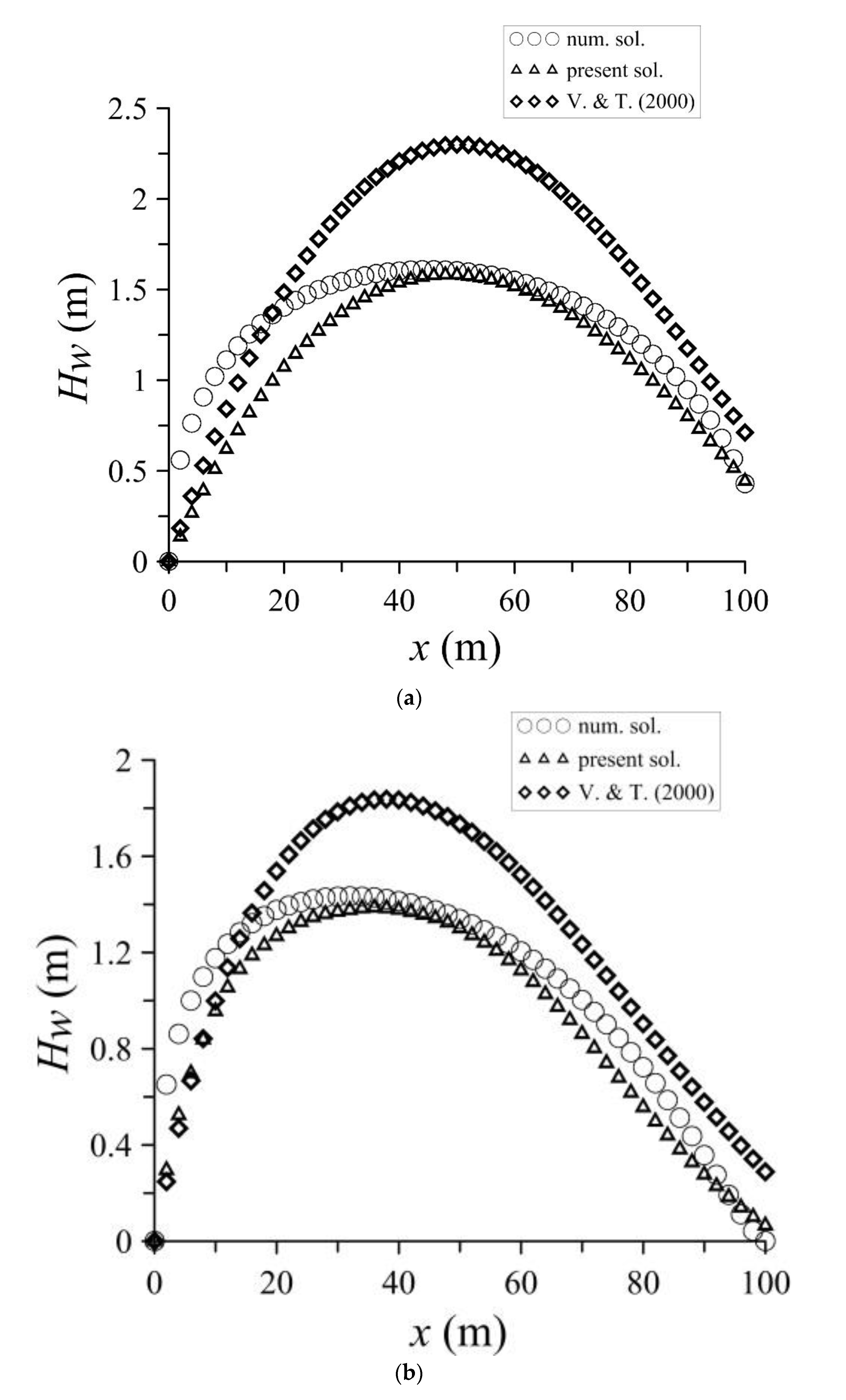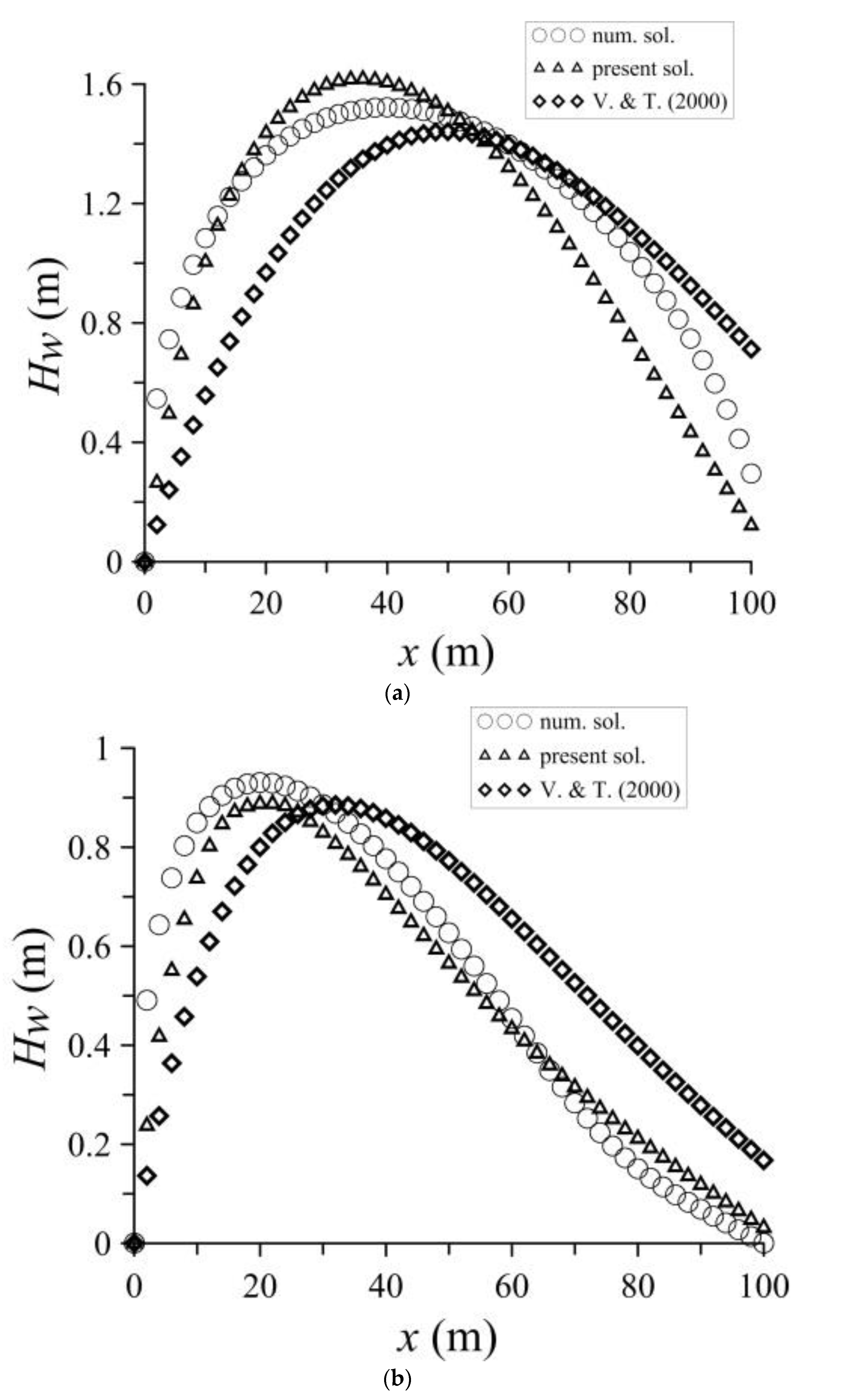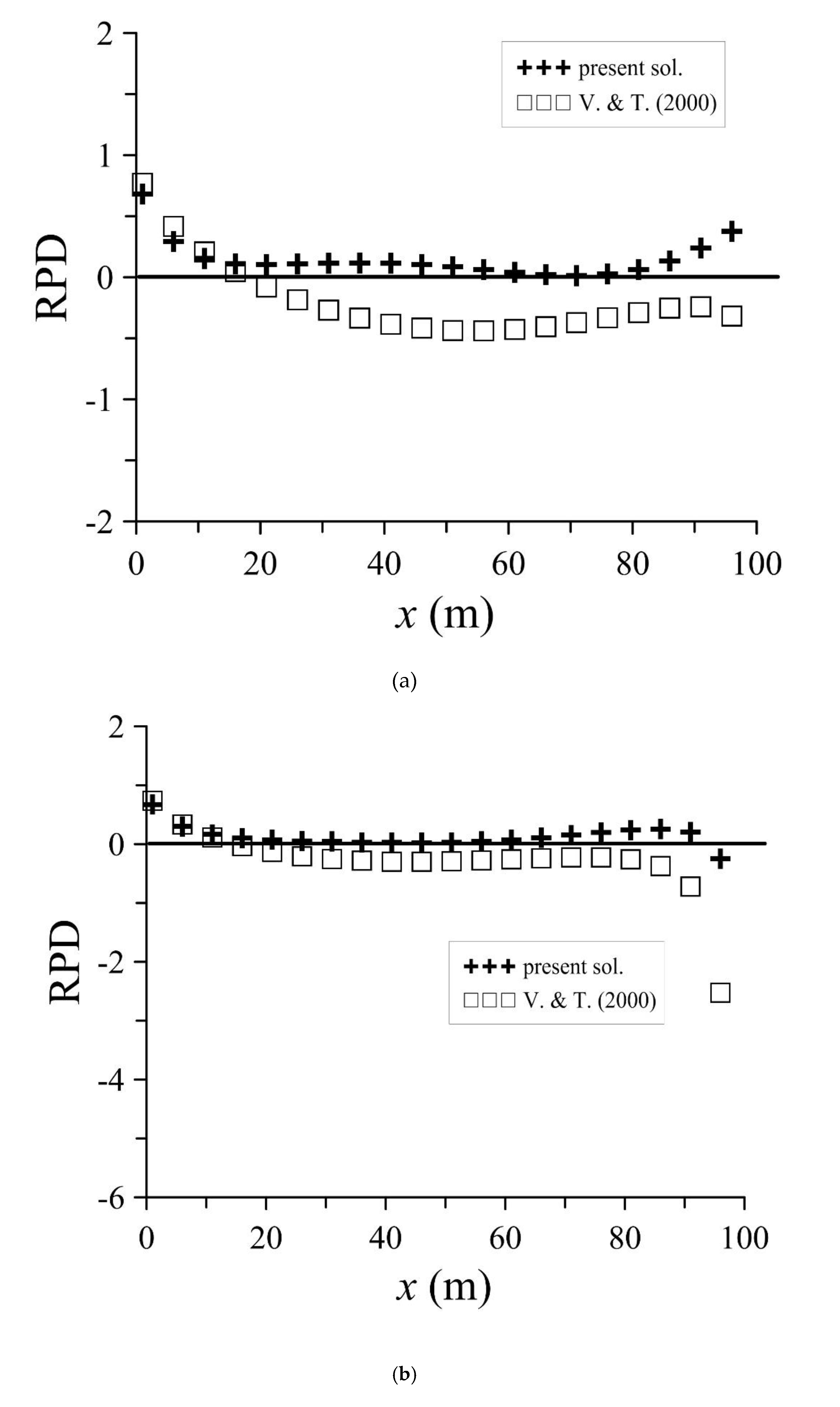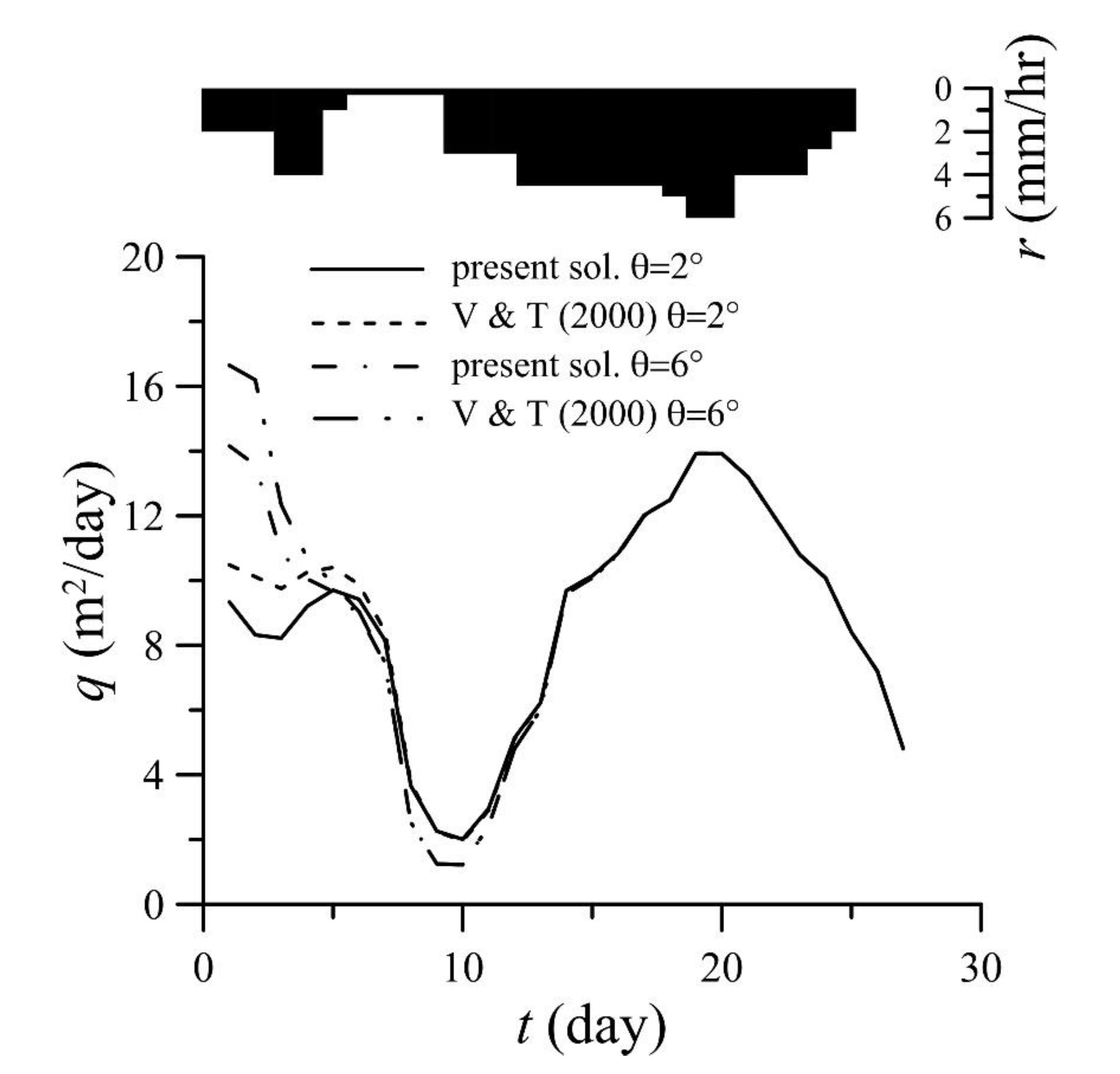Improved Solutions to the Linearized Boussinesq Equation with Temporally Varied Rainfall Recharge for a Sloping Aquifer
Abstract
:1. Introduction
2. Mathematical Formulation
2.1. Conceptual and Mathematical Models
2.2. Present Improved Solutions
3. Results and Discussions
3.1. Comparison of Analytical and Numerical Solutions
3.2. Comparison of Unsteady State and Quasi-Steady State
4. Conclusions
- According to the error analysis, in the case of a constant recharge rate for a sloping aquifer, the results of the proposed solution are better than the results proposed by Verhoest and Troch [7] after comparing with the numerical solutions; therefore, the present analytical solution appears to be more feasible than that proposed in a previous study.
- The proposed solutions reach the convergence criteria faster than the solutions of Verhoest and Troch [7], thus saving computation time.
- The present solution can be directly applied to unsteady recharge rate cases without the requirement of the quasi-steady state method which was employed in the study of Verhoest and Troch [7].
Author Contributions
Funding
Acknowledgments
Conflicts of Interest
References
- Paniconi, C.; Wood, E. A detailed model for simulation of catchment scale subsurface hydrological processes. Water Resour. Res. 1993, 29, 1601–1620. [Google Scholar] [CrossRef]
- Brutsaert, W. The unit response of groundwater outflow from a hillslope. Water Resour. Res. 1994, 30, 2759–2763. [Google Scholar] [CrossRef]
- Chapman, T.G. Recharge-induced groundwater flow over a plane sloping bed: Solutions for steady and transient flow using physical and numerical models. Water Resour. Res. 2005, 41. [Google Scholar] [CrossRef]
- Berne, A.; Uijlenhoet, R.; Troch, P.A. Similarity analysis of subsurface flow response of hillslopes with complex geometry. Water Resour. Res. 2005, 41. [Google Scholar] [CrossRef]
- Troch, P.A.; Paniconi, C.; van Loon, E.E. The hillslope-storage Boussinesq model for subsurface flow and variable source ares along complex hillslopes: 1. Formulation and characteristic response. Water Resour. Res. 2003, 39, 1316. [Google Scholar] [CrossRef]
- Dralle, D.N.; Boisramѐ, G.F.S.; Thompson, A.E. Spatially variable water table recharge and the hillslope hydrologic response: Analytical solutions to the linearized hillslope Boussinesq equation. Water Resour. Res. 2014, 50, 8515–8530. [Google Scholar] [CrossRef]
- Verhoest, E.C.; Troch, P.A. Some analytical solution of the linearized Boussinesq equation with recharge for a sloping aquifer. Water Resour. Res. 2000, 36, 793–800. [Google Scholar] [CrossRef]
- Arfken, G.B.; Weber, H.J. Mathematical Methods for Physicists; Academic Press Inc.: San Diego, CA, USA, 1995. [Google Scholar]
- Zissis, T.S.; Teloglou, I.S.; Terzidis, G.A. Response of a sloping aquifer to constant replenishment and to stream varying water level. J. Hydrol. 2000, 243, 180–191. [Google Scholar] [CrossRef]
- Bansal, R.K.; Das, S.K. Response of an unconfined sloping aquifer to constant recharge and seepage from the stream of varying water level. Water Resour. Manag. 2010, 25, 893–911. [Google Scholar] [CrossRef]
- Kazezyılmaz-Alhan, C.M. An improved solution for diffusion waves to overland flow. Appl. Math Model. 2012, 36, 1465–1472. [Google Scholar] [CrossRef]
- Chapman, T.G. Modeling groundwater flow over sloping beds. Water Resour. Res. 1980, 16, 1114–1118. [Google Scholar] [CrossRef]
- Childs, E.C. Drainage of groundwater resting on a sloping bed. Water Resour. Res. 1971, 7, 1256–1263. [Google Scholar] [CrossRef]
- Özisik, M.N. Boundary Value Problems of Heat Conduction; Dover Publications Inc.: New York, NY, USA, 1968. [Google Scholar]
- Swanson, R.C.; Turkel, E. On central-difference and upwind schemes. J. Comput. Phys. 1992, 101, 292–306. [Google Scholar] [CrossRef]
- Shu, C.-W.; Osher, S. Efficient implementation of essentially non-oscillatory shock capturing schemes. J. Comput. Phys. 1988, 77, 439–471. [Google Scholar] [CrossRef]
- Koussis, A.D. A linear conceptuals ubsurfaces torm flow model. Water Resour. Res. 1992, 28, 1047–1052. [Google Scholar] [CrossRef]









© 2019 by the authors. Licensee MDPI, Basel, Switzerland. This article is an open access article distributed under the terms and conditions of the Creative Commons Attribution (CC BY) license (http://creativecommons.org/licenses/by/4.0/).
Share and Cite
Wu, M.-C.; Hsieh, P.-C. Improved Solutions to the Linearized Boussinesq Equation with Temporally Varied Rainfall Recharge for a Sloping Aquifer. Water 2019, 11, 826. https://doi.org/10.3390/w11040826
Wu M-C, Hsieh P-C. Improved Solutions to the Linearized Boussinesq Equation with Temporally Varied Rainfall Recharge for a Sloping Aquifer. Water. 2019; 11(4):826. https://doi.org/10.3390/w11040826
Chicago/Turabian StyleWu, Ming-Chang, and Ping-Cheng Hsieh. 2019. "Improved Solutions to the Linearized Boussinesq Equation with Temporally Varied Rainfall Recharge for a Sloping Aquifer" Water 11, no. 4: 826. https://doi.org/10.3390/w11040826
APA StyleWu, M.-C., & Hsieh, P.-C. (2019). Improved Solutions to the Linearized Boussinesq Equation with Temporally Varied Rainfall Recharge for a Sloping Aquifer. Water, 11(4), 826. https://doi.org/10.3390/w11040826




